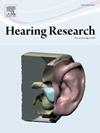人工耳蜗电极阻抗的综合分解
IF 2.5
2区 医学
Q1 AUDIOLOGY & SPEECH-LANGUAGE PATHOLOGY
引用次数: 0
摘要
阻抗遥测是人工耳蜗护理的常规程序,提供对电极-组织界面的见解。分析其电特性有助于通过考虑植入物特异性和组织相关因素来评估患者的预后。这项工作介绍了一种方法来估计阻抗模型的电气元件,以详细表征电极阻抗。我们的方法依赖于临床软件,不需要修改标准测量方案。建立了描述总阻抗随脉冲持续时间变化的数学模型。通过将其拟合到不同脉冲持续时间的阻抗记录中,估计了Warburg电容和Faradaic电阻。将电流返回路径建模为无漏电阻传输线,并根据电压矩阵计算其各个电阻。结果与已建立的估计近场和远场阻抗子分量的几何方法进行了比较。我们观察到几何方法与该方法之间的一致性很强,近场和远场的平均差值分别为155 Ω和-107 Ω,相对平均误差分别为4%和18%。电子元件随时间的演变与先前的研究一致,可以作为表征和监测电极-电解质动态行为的有价值的工具。所提出的方法提供了电极阻抗模型的鲁棒分解,并且可以使用标准软件无缝集成到临床实践中。它为估计电极阵列插入深度、评估残余听力和监测组织反应等应用提供了功能,从而支持临床决策和进一步的研究。本文章由计算机程序翻译,如有差异,请以英文原文为准。

Comprehensive decomposition of cochlear implant electrode impedances
Impedance telemetry is a routine procedure in cochlear implant care, providing insights into the electrode–tissue interface. Analyzing its electrical characteristics helps assess patient outcomes by accounting for implant-specific and tissue-related factors. This work introduces a method to estimate the electrical components of an impedance model for a detailed characterization of electrode impedances. Our approach relies on clinical software, requiring no modifications to standard measurement protocols. A mathematical model describing the total impedance as a function of the pulse duration was introduced. By fitting it to impedance recordings with varying pulse durations, the Warburg capacitance and Faradaic resistance were estimated. The current return path was modeled as a non-leaky resistive transmission line, and its individual resistances were calculated from the voltage matrix. Results were compared to an established geometric approach for estimating near-field and far-field impedance subcomponents. We observed a strong agreement between the geometric method and the proposed approach, indicated by a mean difference of 155 Ω (near-field) and -107 Ω (far-field) and a relative mean error of 4% and 18% respectively. The evolution of the electrical components over time is consistent with previous studies and may serve as a valuable tool for characterizing and monitoring the dynamic behavior of the electrode–electrolyte. The proposed method offers a robust decomposition of the electrode impedance model and can be seamlessly integrated into clinical practice using standard software. It provides features for applications such as estimating electrode array insertion depth, assessing residual hearing, and monitoring tissue responses, thus supporting clinical decision-making and further research.
求助全文
通过发布文献求助,成功后即可免费获取论文全文。
去求助
来源期刊

Hearing Research
医学-耳鼻喉科学
CiteScore
5.30
自引率
14.30%
发文量
163
审稿时长
75 days
期刊介绍:
The aim of the journal is to provide a forum for papers concerned with basic peripheral and central auditory mechanisms. Emphasis is on experimental and clinical studies, but theoretical and methodological papers will also be considered. The journal publishes original research papers, review and mini- review articles, rapid communications, method/protocol and perspective articles.
Papers submitted should deal with auditory anatomy, physiology, psychophysics, imaging, modeling and behavioural studies in animals and humans, as well as hearing aids and cochlear implants. Papers dealing with the vestibular system are also considered for publication. Papers on comparative aspects of hearing and on effects of drugs and environmental contaminants on hearing function will also be considered. Clinical papers will be accepted when they contribute to the understanding of normal and pathological hearing functions.
 求助内容:
求助内容: 应助结果提醒方式:
应助结果提醒方式:


